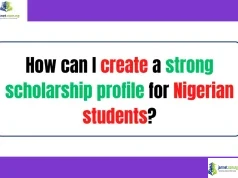Confused about international student loans? This ultimate guide for students in the USA and Canada covers everything from no co-signer options and eligibility to repayment strategies. Get the funding you need to study abroad


Studying in the USA or Canada is an incredible opportunity, but the cost can feel overwhelming. From tuition fees and housing to textbooks and living expenses, funding your education is a major challenge. While scholarships and grants are a huge help, some don’t often cover everything and sometimes becomes difficult to gain. This is where student loans come in.

Join our Telegram Channel for Instant Scholarship Updates
A student loan is a powerful tool that can bridge the financial gap, but only if you know how they work. This guide will walk you through the entire process, from understanding your options and preparing your documents to applying successfully, so you can focus on your studies instead of your finances.
Can International Students Get Loans?
Yes, absolutely. Just like local students, international students can access loans. A student loan is money you borrow that you must repay with interest after you graduate or, in some cases, during your studies. Loans are offered by banks, private lenders, and specific fintech platforms, and they can cover everything from tuition and living expenses to books, health insurance, and even travel.
When applying, you will encounter two key terms that can make or break your application:
- Collateral: An asset (like a house, land, or a savings account) you pledge as security for the loan. If you can’t repay the loan, the lender can take this asset.
- Co-signer: A person, usually a parent, guardian, or relative, who agrees to repay the loan if you are unable to. A co-signer must be a citizen or permanent resident of the country where you’re studying (e.g., a U.S. citizen for a U.S. loan) and have good credit.
Understanding these terms is crucial, as they directly impact your loan eligibility and interest rates.
Step-by-Step Guide to Getting Student Loans in the USA and Canada
Step 1: Understand the Types of Loans Available
Before you apply, you need to know which loans you’re eligible for. Your options are primarily based on your citizenship and whether you have a local cosigner.
- Federal Loans: These are for U.S. citizens and eligible non-citizens. As an international student, you’ll typically need a U.S. or Canadian cosigner to even be considered.
- Private Student Loans: Offered by banks, credit unions, or online lenders. These almost always require a local cosigner with good credit and a strong financial history.
- International Student Loans: These are specifically designed for foreign students. Providers like MPOWER Financing and Prodigy Finance are leaders in this space and often do not require a cosigner or collateral. They evaluate your academic potential and career path instead of just credit history.
Step 2: Check Eligibility Requirements
Your eligibility depends on your program, degree level, and the school’s reputation. While requirements vary by lender, you’ll typically need:
- A valid admission letter from a recognized U.S. or Canadian school.
- Proof of identity (passport, student visa).
- A strong academic record.
- Proof of tuition and living costs (this is often provided by your university).
If you are applying for a loan that requires a co-signer, your co-signer will also need to meet strict income and credit score requirements.
Step 3: Compare Loan Terms & Find the Right Fit
Don’t just look at the interest rate. A savvy borrower compares the entire package. Here’s what you need to evaluate:
- Fixed vs. Variable Interest Rates: A fixed rate stays the same for the life of the loan, offering predictability. A variable rate can change over time, potentially starting lower but carrying the risk of increasing. For long-term peace of mind, a fixed rate is often a safer bet.
- Repayment Period and Grace Period: The grace period is the time after graduation before you must start making full payments, typically six months. Some loans allow you to make small, interest-only payments while you’re still in school, which can significantly reduce the total amount of interest you pay over the life of the loan.
- Fees and Penalties: Check for hidden costs like processing fees or penalties for repaying your loan early. Lenders like MPOWER and Prodigy Finance generally don’t have prepayment penalties.
Step 4: Prepare Your Documents
This is a critical step. A single missing document can delay your entire application. Make a checklist and gather all the necessary paperwork well in advance.
- Admission letter from your university.
- Proof of tuition and living costs (often on the university’s I-20 or enrollment forms).
- ID documents (passport, student visa).
- Your academic transcripts and test scores.
- A Statement of Purpose or an essay explaining your academic goals.
- Your cosigner’s financial documents (if required).
Step 5: Apply Early
Loan approval can take weeks, and you need proof of funding for your visa. A crucial mistake many students make is waiting too long. To avoid delays, you should apply 3–6 months before your classes start. Here’s a sample timeline to follow:
- February – March: Research lenders, understand loan types, and gather initial documents.
- April – May: Submit your loan applications.
- June – July: Await approval and receive your loan offer letter.
- August: Use the loan offer letter as proof of funds for your visa interview.
Top Student Loan Options in the USA and Canada
Here are some of the most popular lenders for international students:
1. MPOWER Financing
- What it is: A highly recommended no-cosigner, no-collateral loan option for international students.
- Eligibility: You must be in the final two years of your undergraduate degree, a postgraduate diploma, or a master’s degree program.
- Loan Amount: Between $2,001 and $100,000.
- Key Features: No cosigner or collateral required. They also offer visa support letters, a key document for your visa application.
2. Prodigy Finance
- What it is: A fintech platform that provides no-cosigner, no-collateral loans for students from many countries.
- Eligibility: Master’s students in specific fields like Business, STEM, Law, and Public Policy at top schools.
- Loan Amount: Can cover up to 100% of tuition and living expenses.
- Key Features: Focuses on your academic success and future earning potential rather than just a credit score.
3. Ascent Funding
- What it is: A lender that supports international students, though it requires a qualified cosigner.
- Eligibility: Requires a U.S.-based cosigner who meets income and credit score requirements.
- Loan Amount: Varies based on your program and financial need.
- Key Features: Offers flexible repayment plans, including options to defer payments for up to 9 months after graduation.
Extra Tips to Increase Your Chances for study in USA student loans Approval
- Maintain Good Academic Performance: Lenders see a strong academic record as a sign of commitment and a lower risk.
- Apply with a Cosigner: If a loan requires a cosigner, find one with a strong credit score. This can lower your interest rate and increase your chances of approval.
- Combine Loans with Scholarships: Don’t put all your eggs in one basket. Actively search for scholarships and grants to reduce the amount you need to borrow, which will make repayment easier in the long run.
- Use Your Loan Offer as Proof of Funds: Remember that your loan offer letter is a critical document for your visa interview, so ensure your lender can provide it promptly.
Based on common search queries and the information gathered, here are the frequently asked questions (FAQs) that would be highly relevant to an international student seeking loans for the USA and Canada. These questions are designed to anticipate and answer the reader’s most pressing concerns, providing a valuable resource.
Frequently Asked Questions (FAQs)
1. Can international students get a loan without a cosigner or collateral? Yes, it is possible. While many traditional banks require a cosigner (a U.S. or Canadian citizen/permanent resident with good credit), specialized private lenders like MPOWER Financing and Prodigy Finance offer loans specifically for international students without a cosigner or collateral. They base their decision on your academic performance and future career potential.
2. What is the difference between a fixed and a variable interest rate? Which one is better? A fixed interest rate stays the same for the entire life of your loan, making your monthly payments predictable. A variable interest rate can change over time based on market conditions, which means your monthly payments could go up or down. A fixed rate is generally considered a safer option for long-term financial planning, while a variable rate might start lower but carries more risk.
3. How much can I borrow, and what expenses can the loan cover? The amount you can borrow depends on the lender and your school’s “Cost of Attendance” (COA). This typically includes tuition, fees, living expenses (housing, food), books, health insurance, and sometimes travel. Most lenders will allow you to borrow up to the full COA, minus any other scholarships or financial aid you’ve received.
4. When should I apply for a student loan? It is highly recommended to apply for a student loan as early as possible. Start the process 3-6 months before your program begins. This is because loan approval can take several weeks, and you will need the loan offer letter as proof of funds for your visa application.
5. What documents are required for the loan application? While requirements vary, you will generally need:
- A valid admission letter from a recognized school.
- Proof of identity (passport, student visa).
- Academic records (transcripts).
- Proof of tuition and living costs (provided by your school).
- Financial documents (bank statements, proof of income) for yourself and your cosigner (if required).
6. What happens if I can’t repay my loan after graduation? If you face financial hardship, the first step is to contact your lender immediately. Most lenders have options like forbearance or deferment, which allow you to temporarily postpone or reduce your payments. Some may also offer flexible repayment plans based on your income. Ignoring the issue can lead to serious consequences, including damage to your credit history.
7. Can I get a student loan to cover a specific university or program? Many lenders, particularly those that offer no-cosigner loans, have a list of approved schools and programs. You must be attending an eligible institution to qualify. It’s essential to check the lender’s list before you apply.
8. Do international student loans have a prepayment penalty? This depends on the lender. Some lenders, like MPOWER Financing, do not charge a penalty for early repayment, which can be a great way to save on total interest. However, others might, so it’s crucial to read the terms and conditions carefully before signing your loan agreement.
By following these steps, you can confidently navigate the student loan application process. It’s a crucial step toward making your dream of studying in the USA or Canada a reality.













